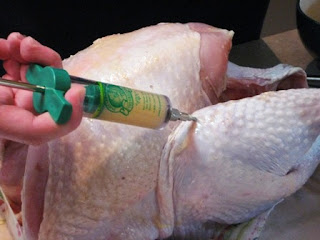Luckily the hubby was great about photographing his deep-fried turkey, which was more exciting than what I made, anyway. It’s crispy, and juicy, and so incredibly flavorful that I nearly weep with joy.
Deep-fried turkey has been a hubby specialty for years, and he studied the process and instructions thoroughly before attempting it. For example, the instruction booklet strictly forbade dogs from jumping into the turkey fryer; at no time have we allowed such a thing. (The instructions mentioned nothing about small children, but we just kind of assumed.)
A few tips for safe turkey frying this holiday season:
- Set up your turkey fryer on stable, level ground, such as concrete. You really don’t want your bubbling turkey fryer to tip over onto, say, your foot.
- Keep the temperature of your oil around 325 to 350 degrees. If you get around that 375 to 400 or so mark, your oil can smoke and/or ignite. (I’m not expert, but I think ignited oil is bad.)
- Choose a modestly sized turkey (or two). We usually do in the vicinity of 14-17 pounds. Any bigger, and the oil can bubble over the top of the pot. (The instruction fryer for your manual should recommend the appropriately sized turkey.)
- Thaw your turkey completely. Otherwise the frozen turkey can cause the oil to bubble over the top of the pot.
- Do not fill your fryer too full of oil. Otherwise the oil can bubble over the top of the pot.
- Do not put your turkey in the fryer too quickly. Otherwise the oil can bubble over the top of the pot.
Clearly, the oil bubbling over the top of the pot is less than desirable. Why? Because the oil can run down into the flame under the pot, causing a greasefire, which can ignite the hose that leads to the propane tank, which can cause the propane tank to go boom. (I’m sure you can find videos online.)
So you’ve got a fully thawed turkey; what’s next? First you want to remove the neck and giblets. Trim any extra skin and fat from the tail and neck area. Hey, ya know what?
 Turkey butt. Hahahahaha, I kill me. Next, rinse the poor thing.
Turkey butt. Hahahahaha, I kill me. Next, rinse the poor thing.Then, if you’re smart, you’ll inject and rub your bird. We’ve tried several rubs and marinades, both storebought and homemade, and this is our favorite by far.

Insert the turkey hanger hook (this comes with your fryer) into the turkey, and carry the turkey to the fryer using the hanger. Hold the hanger and, VERY SLOWLY, lower the turkey into the oil. This isn’t like tossing mozzarella sticks into the deep fryer; you need to lower the turkey slightly, and then give the oil time to adjust so the bubblage starts to calm down. Then lower slightly, etc. (In all, this can take 2-3 minutes.)
As far as timing the turkey, a pretty reliable calculation is 3 1/2 minutes per pound, if you’re keeping your oil temperature in that 325 to 350 range.
Then grab your trusty hanger and a pal to hold the door while you carry your precious cargo. First, shut the valve on your propane tank. (Safety first!) Then remove the lid, insert your hanger back into the hanger hook, and lift the turkey from the oil. Hold the turkey above the pot for a minute or two to drain any excess oil before bringing the turkey inside.












1 comment:
Alyssa, you don't brine your turkey?
Post a Comment